 W
WThe Arctic shrew, also known as the blackback shrew or saddlebacked shrew, is a medium-sized shrew found in Canada and the northern United States. Separate species status has been proposed for the maritime shrew which is found in New Brunswick and Nova Scotia and had been considered to be a subspecies of the Arctic shrew. The tundra shrew was formerly considered to be a subspecies of the Arctic shrew.
 W
WThe black-and-white ruffed lemur is an endangered species of ruffed lemur, one of two which are endemic to the island of Madagascar. Despite having a larger range than the red ruffed lemur, it has a much smaller population that is spread out, living in lower population densities and reproductively isolated. It also has less coverage and protection in large national parks than the red ruffed lemur. Three subspecies of black-and-white ruffed lemur have been recognized since the red ruffed lemur was elevated to species status in 2001.
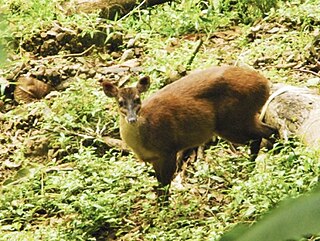 W
WThe Central American red brocket is a species of brocket deer ranging from southern Mexico, through Central America, to northwestern Colombia. It was formerly treated as a subspecies of the red brocket from South America, but its karyotype has 2n = 50, while the latter's was initially described as having 2n = 68–70. However, a more recent description gives the red brocket a variable karyotype with 2n ranging from 48 to 54, suggesting it represents several species. It is sympatric with the Yucatan brown brocket over part of its range. Additionally, it was estimated that the Mazama temama diverged from other red brocket deer about 2 MYA. This was estimated through analysis of concatenated sequences from the mitochondrial gene ND2, Cytb, and tRNA-Pro-Control region. The species is found in primary and secondary tropical forest at altitudes from sea level to 2800 m. In Mexico, it is regarded as an agricultural pest by bean farmers. It is probably threatened by hunting and deforestation.
 W
WThe chacma baboon, also known as the Cape baboon, is, like all other baboons, from the Old World monkey family. It is one of the largest of all monkeys. Located primarily in southern Africa, the chacma baboon has a wide variety of social behaviors, including a dominance hierarchy, collective foraging, adoption of young by females, and friendship pairings. These behaviors form parts of a complex evolutionary ecology. In general, the species is not threatened, but human population pressure has increased contact between humans and baboons. Hunting, trapping, and accidents kill or remove many baboons from the wild, thereby reducing baboon numbers and disrupting their social structure.
 W
WThe cinereous shrew or masked shrew is a small shrew found in Alaska, Canada, and the northern United States. This is the most widely distributed shrew in North America, where it is also known as the common shrew.
 W
WThe collared mangabey, also known as the red-capped mangabey, or the white-collared mangabey, is a species of primate in the family Cercopithecidae of Old World monkeys. It formerly included the sooty mangabey as a subspecies. As presently defined, the collared mangabey is monotypic.
 W
WThe common brushtail possum is a nocturnal, semi-arboreal marsupial of the family Phalangeridae, native to Australia, and the second-largest of the possums.
 W
WThe North American cougar is a cougar subspecies in North America. It was once common in eastern North America, and is still prevalent in the western half of the continent. This subspecies includes populations in western Canada, the western United States, Florida, Mexico and Central America, and possibly South America northwest of the Andes Mountains. It is the biggest cat in North America, with North American jaguars being fairly small. It thus includes the extirpated Eastern cougar and extant Florida panther populations.
 W
WThe short-beaked echidna is one of four living species of echidna and the only member of the genus Tachyglossus. It is covered in fur and spines and has a distinctive snout and a specialized tongue, which it uses to catch its insect prey at a great speed. Like the other extant monotremes, the short-beaked echidna lays eggs; the monotremes are the only group of mammals to do so.
 W
WThe Falkland Islands wolf, also known as the warrah and occasionally as the Falkland Islands dog, Falkland Islands fox, or Antarctic wolf, was the only native land mammal of the Falkland Islands. It became extinct in 1876, the first known canid to have become extinct in historical times.
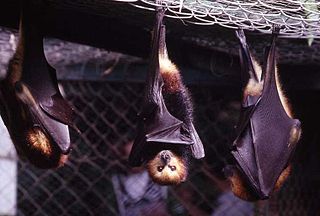 W
WThe Mauritian flying fox, also known as Greater Mascarene flying fox or Mauritius fruit bat is a large megabat species endemic to Mauritius and La Réunion.
 W
WThe small Mauritian flying fox or dark flying fox is an extinct species of megabat. It lived on the islands of Réunion and Mauritius in the Mascarene Islands of the Indian Ocean. It was abundant, with up to 400 sometimes crowding together at a single roost in a cave or in an ancient, hollow tree, while most other fruit bats prefer to roost in the branches of large trees. Local people believed there was only one male per roost, which may indicate the sexes roosted separately and the large roosts were maternity colonies. This flying fox was nocturnal and had delicate teeth, so it probably fed on nectar and possibly soft fruit.
 W
WThe giant armadillo, colloquially tatou, ocarro, tatu-canastra or tatú carreta, is the largest living species of armadillo. It lives in South America, ranging throughout as far south as northern Argentina. This species is considered vulnerable to extinction.
 W
WThe great jerboa is a species of rodent in the family Dipodidae. It is found in Kazakhstan, Russia, Turkmenistan, Ukraine and Uzbekistan. It mainly lives in deserts.
 W
WThe greater glider is the common name for three species of large gliding marsupials found in Australia. Until 2020 they were considered to be one species, Petauroides volans. In 2020 morphological and genetic differences, obtained using diversity arrays technology, showed there were three species subsumed under this one name. The two new species were named Petauroides armillatus and Petauroides minor.
 W
WThe greater mouse-tailed bat is a species of bat in the Rhinopomatidae family.
 W
WThe Indian crested porcupine is a hystricomorph rodent species native to southern Asia and the Middle East. It is listed as Least Concern on the IUCN Red List. It belongs to the Old World porcupine family, Hystricidae.
 W
WThe leopard cat is a small wild cat native to continental South, Southeast, and East Asia. Since 2002 it has been listed as Least Concern on the IUCN Red List as it is widely distributed although threatened by habitat loss and hunting in parts of its range.
 W
WThe long-nosed potoroo is a species of potoroo. These small marsupials are part of the rat-kangaroo family. The long-nosed potoroo contains two subspecies, P. t. tridactylus from Mainland Australia, and P. t. apicalis from Tasmania, which tends to have lighter fur than P. t. tridactylus. At first glance, the long-nosed potoroo with its pointed nose and grey-brown fur looks very much like a bandicoot — that is, until it hops away with its front feet tucked into its chest, revealing its close relationship with the kangaroo family. The long-nosed potoroo exhibits many morphological specializations such as an elongated pointed rostral region (nose), erect ears, large eyes, claws for digging, and long robust hind legs. It is only a small marsupial, with a body length between 34 and 38 cm (13–15 in), and a semi-prehensile tail length of 15 to 24 cm (5.9–9.4 in).
 W
WThe Canada lynx is a medium-sized North American wildcat that ranges across Alaska, Canada and many of the contiguous United States. It is characterized by its long, dense fur, triangular ears with black tufts at the tips, and broad, snowshoe-like paws. As in the bobcat, the lynx's hindlimbs are longer than the forelimbs, so the back slopes downward to the front. The Canada lynx stands 48–56 cm (19–22 in) tall at the shoulder and weighs between 5 and 17 kg. The lynx is a good swimmer and an agile climber. The Canada lynx was first described by Robert Kerr in 1792. Three subspecies have been proposed, but their validity is doubted.
 W
WThe Virginia opossum, commonly known as the North American opossum, is the only marsupial found north of Mexico. In the United States, the animal is typically referred to simply as a possum. It is a solitary and nocturnal animal about the size of a domestic cat. It is a successful opportunist. It is familiar to many North Americans as they frequently inhabit settled areas due to the associated proximity to food sources, notably trash cans.
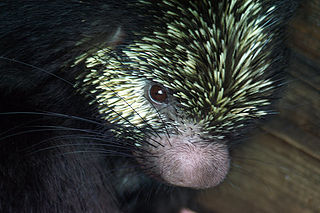 W
WThe Mexican hairy dwarf porcupine or Mexican tree porcupine is a species of rodent in the family Erethizontidae. It is found in Costa Rica, El Salvador, Guatemala, Honduras, Panama, Mexico, Nicaragua and Belize.
 W
WThe Mauritian flying fox, also known as Greater Mascarene flying fox or Mauritius fruit bat is a large megabat species endemic to Mauritius and La Réunion.
 W
WThe sambar is a large deer native to the Indian subcontinent, South China, and Southeast Asia that is listed as a vulnerable species on the IUCN Red List since 2008. Populations have declined substantially due to severe hunting, insurgency, and industrial exploitation of habitat.
 W
WThe Seychelles fruit bat or Seychelles flying fox is a megabat found on the granitic islands of Seychelles, and on the Comoros and Mafia Island. It is a significant component of the ecosystems for the islands, dispersing the seeds of many tree species. Although it is hunted for meat on some islands, it remains abundant. It is particularly common on Silhouette Island.
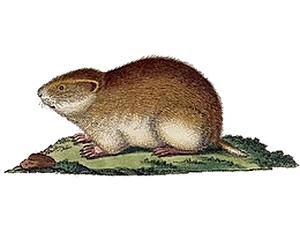 W
WThe Siberian brown lemming is a species of rodents in the family Cricetidae found in the Russian Federation. It does not hibernate during winter; it lives in burrows. It is prey to several animals, including the snowy owl and the Arctic fox. The lemmings are known for their high-amplitude, large-scale fluctuations of population sizes.
 W
WThe Arctic shrew, also known as the blackback shrew or saddlebacked shrew, is a medium-sized shrew found in Canada and the northern United States. Separate species status has been proposed for the maritime shrew which is found in New Brunswick and Nova Scotia and had been considered to be a subspecies of the Arctic shrew. The tundra shrew was formerly considered to be a subspecies of the Arctic shrew.
 W
WThe squirrel glider is a nocturnal gliding possum. The squirrel glider is one of the wrist-winged gliders of the genus Petaurus.
 W
WThe straw-coloured fruit bat is a large fruit bat that is the most widely distributed of all the African megabats. It is quite common throughout its area ranging from the southwestern Arabian Peninsula, across forest and savanna zones of sub-Saharan Africa. It is listed as Near Threatened on the IUCN Red List due to a decreasing population trend. Straw-coloured fruit bats travel in massive colonies of at least 100,000 bats and sometimes massing up to 1 million. From October to end of December every year, in the largest migration of mammals on the planet, up to 10 million straw-coloured fruit bats congregate in Kasanka National Park, Zambia, roosting in a 2 hectare area of Mushitu forest each day. This migration was only discovered in 1980. Their necks and backs are a yellowish-brown colour, while their undersides are tawny olive or brownish.
 W
WThe tiger quoll, also known as the spotted-tail quoll, the spotted quoll, the spotted-tail dasyure, native cat or the tiger cat, is a carnivorous marsupial of the quoll genus Dasyurus native to Australia. With males and females weighing around 3.5 and 1.8 kg, respectively, it is the world's second largest extant carnivorous marsupial, behind the Tasmanian devil. Two subspecies are recognised; the nominate is found in wet forests of southeastern Australia and Tasmania, and a northern subspecies, D. m. gracilis, is found in a small area of northern Queensland and is endangered.
 W
WThe tundra wolf, also known as the Turukhan wolf, is a subspecies of grey wolf native to Eurasia's tundra and forest-tundra zones from Finland to the Kamchatka Peninsula. It was first described in 1792 by Robert Kerr, who described it as living around the Yenisei, and of having a highly valued pelt.
 W
WThe western red colobus, also known as the bay red colobus, rust red colobus or Upper Guinea red colobus, is a species of Old World monkey in West African forests from Senegal to Ghana. All other species of red colobuses have formerly been considered subspecies of P. badius. It is often hunted by the common chimpanzee. In 1994, western red colobus monkeys infected many chimpanzees with Ebola virus when the chimpanzees hunted the monkeys as prey.
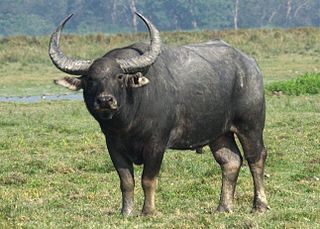 W
WThe wild water buffalo, also called Asian buffalo, Asiatic buffalo and wild Asian buffalo, is a large bovine native to the Indian subcontinent and Southeast Asia. It has been listed as Endangered in the IUCN Red List since 1986, as the remaining population totals less than 4,000. A population decline of at least 50% over the last three generations is projected to continue. The global population has been estimated at 3,400 individuals, of which 3,100 (91%) live in India, mostly in Assam. The wild water buffalo is the probable ancestor of the domestic water buffalo.